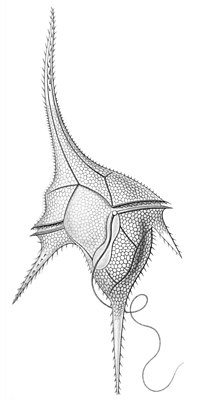
Photo from wikipedia
Harmful algal blooms (HABs) caused by Karenia mikimotoi have frequently happened in coastal waters worldwide, causing serious damages to marine ecosystems and economic losses. Photocatalysis has potential to in-situ inhibit… Click to show full abstract
Harmful algal blooms (HABs) caused by Karenia mikimotoi have frequently happened in coastal waters worldwide, causing serious damages to marine ecosystems and economic losses. Photocatalysis has potential to in-situ inhibit algal growth using sustainable sunlight. However, the inactivation and detoxification mechanisms of microalgae in marine environment have not been systematically investigated. In this work, for the first time, visible-light-driven photocatalytic inactivation of K. mikimotoi was attempted using g-C3N4/TiO2 immobilized films as a model photocatalyst. The inactivation efficiency could reach 64% within 60 min, evaluated by real-time in vivo chlorophyll-a fluorometric method. The immobilized photocatalyst films also exhibited excellent photo-stability and recyclability. Mechanisms study indicated photo-generated h+ and 1O2 were the dominant reactive species. Algal cell rupture process was monitored by fluorescent microscope combined with SEM observation, which confirmed the damage of cell membrane followed by the leakage of the intracellular components including the entire cell nucleus. The physiological responses regarding up-regulation of antioxidant enzyme activity (i.e. CAT and SOD), intracellular ROSs level and lipid peroxidation were all observed. Moreover, the intracellular release profile and acute toxicity assessment indicated the toxic K. mikimotoi was successfully detoxified, and the released organic matter had no cytotoxicity. This work not only provides a potential new strategy for in-situ treatment of K. mikimotoi using sunlight at sea environments, but also creates avenue for understanding the inactivation and destruction mechanisms of marine microalgae treated by photocatalysis and the toxicity impacts on the marine environments.
Journal Title: Environmental research
Year Published: 2021
Link to full text (if available)
Share on Social Media: Sign Up to like & get
recommendations!